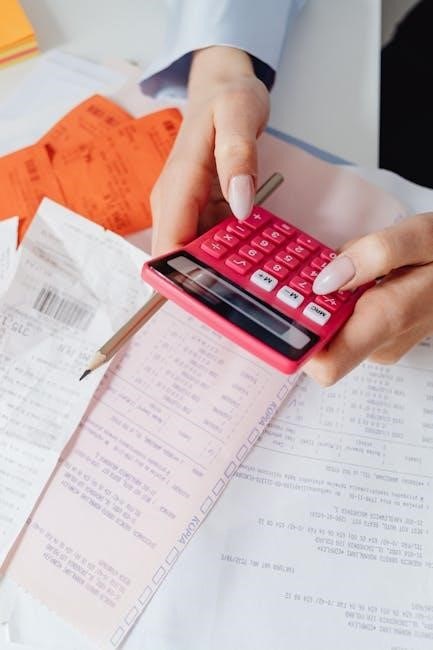Rational numbers are a fundamental concept in mathematics, representing fractions of integers. They are essential in various mathematical operations and problem-solving, making them a cornerstone of math education.
1.1 Definition and Basics of Rational Numbers
Rational numbers are defined as numbers that can be expressed as the quotient of two integers, where the denominator is non-zero. They can be positive, negative, or zero. Examples include fractions like 1/2, -3/4, and whole numbers like 5, which can be written as 5/1. Rational numbers are fundamental in mathematics, forming the basis for various operations and problem-solving. They are closed under addition, subtraction, multiplication, and division (except division by zero). Understanding their properties is essential for advanced mathematical concepts.
1.2 Importance of Understanding Rational Numbers
Understanding rational numbers is crucial as they form the cornerstone of arithmetic operations. They enable precise measurements and fractions in real-life applications, such as cooking, engineering, and finance. Mastery of rational numbers enhances problem-solving skills and prepares students for algebra and higher mathematics. Worksheets on rational numbers provide essential practice, reinforcing concepts like equivalence, ordering, and operations, ensuring a solid foundation for mathematical literacy and future academic success.
Identifying Rational Numbers
Rational numbers can be expressed as fractions of integers, such as 1/2 or 3/4. They include all integers, terminating decimals, and repeating decimals. Worksheets help identify and classify rational numbers through true/false questions and multiple-choice exercises, ensuring a clear understanding of their properties and applications in mathematics.
2.1 What Constitutes a Rational Number?
A rational number is any number that can be expressed as the ratio of two integers, such as 1/2 or -3/4. This includes all integers, terminating decimals like 0.5, and repeating decimals like 0.333…. Worksheets often feature true/false questions and exercises to identify these numbers, reinforcing the understanding that they can be written in fractional form, making them a fundamental concept in mathematics.
2.2 How to Determine if a Number is Rational
To determine if a number is rational, check if it can be expressed as a fraction of two integers, such as a/b, where a and b are integers and b ≠ 0. This includes integers, terminating decimals, and repeating decimals; For example, 0.5 is rational because it equals 1/2, and -3/4 is rational. Worksheets often include exercises like identifying rational numbers between fractions or solving problems to reinforce this concept.
Operations on Rational Numbers
Operations like addition, subtraction, multiplication, and division of rational numbers are fundamental. Worksheets often include exercises to practice these operations, ensuring mastery of rational number arithmetic.
3.1 Addition and Subtraction of Rational Numbers
Addition and subtraction of rational numbers involve common denominators. Worksheets provide exercises like comparing fractions and mixed numbers. For example, adding 1/2 and 3/4 requires a common denominator, resulting in 7/4. Subtracting 5/6 — 2/3 involves converting to similar fractions, yielding 1/2. These operations are crucial for understanding more complex math concepts and are widely practiced in educational resources.
3.2 Multiplication and Division of Rational Numbers
Multiplication and division of rational numbers are essential skills. Worksheets offer problems like multiplying 2/3 by 4/5, resulting in 8/15, and dividing 6/7 by 2/3, yielding 9/7. These operations are fundamental for advanced math and real-world applications. Practice materials, such as worksheets, help students master these concepts through varied exercises and clear examples, ensuring a solid foundation in rational number operations.

Comparing and Ordering Rational Numbers
Comparing and ordering rational numbers involves techniques like finding common denominators or comparing numerators. This skill is crucial for understanding number relationships and solving equations effectively.
4.1 Techniques for Comparing Rational Numbers
Comparing rational numbers can be done by converting them to decimals or finding common denominators. Decimal conversion simplifies comparison, while common denominators allow direct numerator comparison. Both methods ensure accuracy in determining which number is larger or smaller. These techniques are essential for ordering rational numbers in ascending or descending order, a skill widely used in problem-solving and real-world applications. Regular practice with worksheets helps master these comparison methods efficiently.
4.2 Ordering Rational Numbers in Ascending or Descending Order
Ordering rational numbers involves arranging them from smallest to largest (ascending) or largest to smallest (descending). This process is crucial for understanding number lines and intervals. Worksheets often include exercises where students list numbers in sequence, enhancing their ability to recognize patterns and relationships. Proper ordering is vital for advanced mathematical concepts, making it a key skill to master through consistent practice and review of fundamental techniques.
Equivalent Fractions and Simplification
Equivalent fractions represent the same value in different forms, aiding in simplifying expressions and solving problems. Worksheets provide exercises to identify and create these fractions, enhancing math skills effectively.
5.1 Finding Equivalent Fractions
Finding equivalent fractions involves multiplying or dividing both the numerator and denominator by the same non-zero number. This process maintains the fraction’s value while altering its form. Worksheets often include exercises where students identify and create equivalent fractions, improving their understanding of fractional relationships. For instance, 1/2, 2/4, and 3/6 are equivalent because they simplify to the same value. This concept is crucial for operations like addition and subtraction of rational numbers, where having common denominators is essential. By practicing these skills, students enhance their ability to manipulate and compare fractions effectively. These exercises also lay the groundwork for more complex mathematical concepts, such as simplifying algebraic expressions and solving equations involving fractions. Regular practice with equivalent fractions helps build a strong foundation in rational numbers, making it easier to tackle advanced topics in mathematics. Additionally, understanding equivalent fractions is vital in real-world applications, such as cooking, construction, and finance, where precise measurements and calculations are necessary. Through systematic practice and review, students can master the art of identifying and generating equivalent fractions, thereby improving their overall mathematical proficiency.
5.2 Simplifying Rational Numbers to Their Lowest Terms
Simplifying rational numbers involves reducing fractions to their lowest terms by dividing both the numerator and denominator by their greatest common divisor (GCD). This ensures the fraction represents the smallest possible whole number ratio. For example, 4/6 simplifies to 2/3. Worksheets often include exercises for simplifying fractions, which is essential for performing operations like addition and subtraction. Mastering this skill enhances mathematical proficiency and is crucial for real-world applications, such as budgeting or cooking, where precise measurements are necessary.
Finding Rational Numbers Between Two Given Numbers
Rational numbers are densely ordered, meaning infinitely many exist between any two given rationals. This property is explored in worksheets through exercises like identifying multiples or mediant fractions.
6.1 Methods to Identify Rational Numbers Between Two Fractions
To find rational numbers between two fractions, methods include averaging the numerators or denominators, adjusting fractions to create intermediate values, or converting to equivalent fractions by multiplying numerator and denominator by the same number. These techniques leverage the density of rational numbers, ensuring infinitely many exist between any two given fractions. Worksheets often provide exercises like identifying multiples or mediant fractions to practice these skills, reinforcing the understanding of rational number properties.
6.2 Understanding the Density of Rational Numbers
Rational numbers are densely ordered, meaning between any two distinct rational numbers, there are infinitely many others. This property ensures that no matter how close two fractions seem, additional rationals always exist between them. Worksheets often explore this concept through problems requiring identification of multiple rational numbers within specific intervals, emphasizing the infinite nature of rationals and their distribution across the number line, thus deepening the understanding of their density and ubiquity in mathematics.

Worksheet Exercises and Problems
Worksheet exercises provide hands-on practice with rational numbers, including true/false questions, multiple-choice, and short-answer problems. These exercises cover operations, comparisons, and real-world applications, ensuring comprehensive understanding and application of rational number concepts.
7.1 True/False Questions on Rational Numbers
True/false questions test understanding of basic concepts. Examples include: “All natural numbers are whole numbers,” “0 is a natural number,” and “There are infinitely many rational numbers between any two fractions.” These questions assess foundational knowledge and promote critical thinking, ensuring students grasp essential definitions and properties of rational numbers before advancing to more complex problems.
7.2 Short Answer Questions for Practice
Short answer questions provide in-depth practice, such as finding rational numbers between fractions or identifying equivalent fractions. For example, “Write three rational numbers between 1/3 and 4/5” or “Find a rational number equivalent to 18/29 with 87 as the denominator.” These exercises enhance understanding by applying concepts to specific problems, reinforcing skills in fraction manipulation and rational number properties, and preparing students for more advanced mathematical challenges.

Answer Key and Solutions
This section provides detailed answers and explanations for the worksheet problems. It helps students verify their work and understand key concepts and formulas effectively.
8.1 Detailed Solutions for Worksheet Problems
Each problem is solved step-by-step, ensuring clarity and understanding. Solutions cover operations like addition, subtraction, multiplication, and division of rational numbers. Examples include simplifying fractions, comparing values, and applying real-world contexts. The explanations are thorough, addressing common misconceptions and highlighting key properties of rational numbers. This resource is invaluable for students seeking to master rational number concepts and excel in their studies.
8.2 Explanation of Key Concepts and Formulas
Key concepts include definitions, properties, and operations with rational numbers. Formulas for addition, subtraction, multiplication, and division are provided. The density and closure properties are explained, along with simplification techniques. These explanations are clear and concise, ensuring a solid foundation for understanding and applying rational numbers in various mathematical contexts, fostering both theoretical knowledge and practical problem-solving skills.
Advanced Topics in Rational Numbers
Explore operations with mixed numbers and improper fractions, and discover real-world applications of rational numbers in finance, engineering, and science, enhancing problem-solving skills and practical understanding.
9.1 Operations Involving Mixed Numbers and Improper Fractions
Mixed numbers and improper fractions are essential in advanced rational number operations. Convert mixed numbers to improper fractions for easier calculations. Practice addition, subtraction, multiplication, and division, ensuring proper simplification. These skills are crucial for real-world applications like cooking, construction, and finance. Worksheets provide structured exercises to master these operations, reinforcing understanding and improving math fluency for students at all levels.
9.2 Real-World Applications of Rational Numbers
Rational numbers are vital in everyday scenarios, including cooking, budgeting, and engineering. For instance, recipes often require fractional measurements, while financial calculations involve fractions of dollars. Engineers use rational numbers for precise measurements and ratios. Worksheets with real-world problems help students connect abstract concepts to practical uses, enhancing their understanding and applicability of rational numbers in diverse fields. This makes math more relatable and relevant, fostering problem-solving skills for real-life situations.

Additional Resources and References
Explore online tutorials, study guides, and interactive tools for rational numbers. Websites like Easy Teacher Worksheets and CEMC offer comprehensive resources for practice and learning.
10.1 Recommended Worksheets for Further Practice
Enhance your understanding with worksheets from trusted sources like Easy Teacher Worksheets and CEMC.UWATERLOO.CA. These resources offer a variety of exercises, including true/false questions, short answers, and operations on rational numbers. Worksheets like “Grade 9 ‒ Rational Numbers ‒ Answer Key.pdf” provide detailed solutions and explanations. They cover topics such as comparing rational numbers, finding equivalents, and simplifying fractions. These tools are ideal for students seeking additional practice to master rational number concepts.
10.2 Links to Online Tutorials and Study Materials
Access comprehensive resources like Easy Teacher Worksheets and CEMC.UWATERLOO.CA for in-depth rational number studies. These platforms offer detailed guides, video tutorials, and interactive exercises. Websites such as Grade 9 — Rational Numbers provide answer keys and step-by-step solutions. Additionally, online forums and educational portals like Khan Academy and Mathway offer practice problems and real-world applications. These tools are invaluable for mastering rational number concepts and operations.




